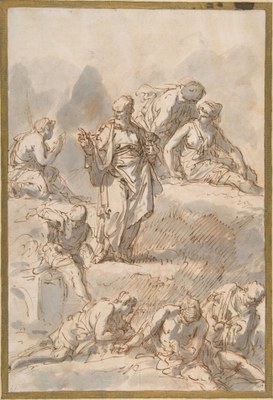Giulia Forti // Drawing in the workshop. The functions of drawing in 18th century Venetian ateliers, from Ricci to Tiepolo
Is there a codified modus operandi in the workshops of Venetian painters in the Eighteenth century? What is the function of drawing in the rhetorical process of imitatio/aemulatio of a Master's invention by his pupils? And what is the contribution of drawing in the process of coding and spreading of an artistic canon, inside and outside the workshop?
The two-month research stay at the Zentralinstitut für Kunstgeschichte in Munich will be part of a larger project, which aims to answer these and other pivotal questions, investigating and analyzing the functions assigned to drawing in Settecento venetian workshops. The ultimate goal of the research is to shed new light on the reality of venetian ateliers in the 18th c., using drawing as a research tool, a magnifying glass on the operating practices of an artist and his team.  The research will develop as a dialectic discourse, comparing, for the first time, the "workshop systems" of the two founding pillars of the Settecento veneziano: on the one hand Sebastiano Ricci (1659-1734), on the other Giambattista Tiepolo (1696-1770). The figures of Francesco Fontebasso (1707-1769) and Gaspare Diziani (1689-1767), and their alleged - but so far never investigated - workshops, will also be examined, as they seem to be particularly revealing of a transition moment between the two "universes” of Ricci and Tiepolo.
The research will develop as a dialectic discourse, comparing, for the first time, the "workshop systems" of the two founding pillars of the Settecento veneziano: on the one hand Sebastiano Ricci (1659-1734), on the other Giambattista Tiepolo (1696-1770). The figures of Francesco Fontebasso (1707-1769) and Gaspare Diziani (1689-1767), and their alleged - but so far never investigated - workshops, will also be examined, as they seem to be particularly revealing of a transition moment between the two "universes” of Ricci and Tiepolo.
The peculiar aspects of Ricci’s workshop practice, with special regards to drawing, will therefore be highlighted. His method had imposed in Venice at the beginnings of the century, and perpetuated thanks to Fontebasso and Diziani. But innovations were soon introduced by Tiepolo, who, in his approach to drawing, and in his management of complex realizations, such as that of the Würzburg Residenz, reveals an unprecedented working method. As mentioned, the investigation will focus on the graphic production, intended as a privileged access key to the understanding of the daily practice of these workshops.
During the research stay in Monaco, in particular, I will be focusing on the study of three extremely significant and revealing graphic groups. In the case of Fontebasso, the so-called Meatyard Album, a collection of over sixty sheets, once bound in an account book, now dispersed in various museum collections, or on the market, and only partially published. I will try to reconstruct the album as a whole, with a complete recognition of the existing material, in order to clarify not only its attribution – more hands can be identified, in addition to that of the Master –, but above all the actual function, in relation to what Francesco had learned from Ricci, without forgetting a possible impact of Giambattista Tiepolo’s new methods. As for Diziani, I will dedicate myself to the Artaria Konvolut, preserved at the Städel Museum in Frankfurt, which opens up a series of questions not only on the attribution and chronology, but also on the actual sense and function of the drawings in the context of the little-known workshop of Diziani. Finally, with regard to Tiepolo, I will devote my attention to a preliminary study of the sheets in Würzburg and Stuttgart, which introduce the theme of the involvement of his son Giandomenico in the creation of ricordi for the workshop.
Sebastiano Ricci, Studi di figure. New York, Metropolitan Museum of Art | Abbildungsnachweis: Creative Commons https://creativecommons.org/publicdomain/zero/1.0/
